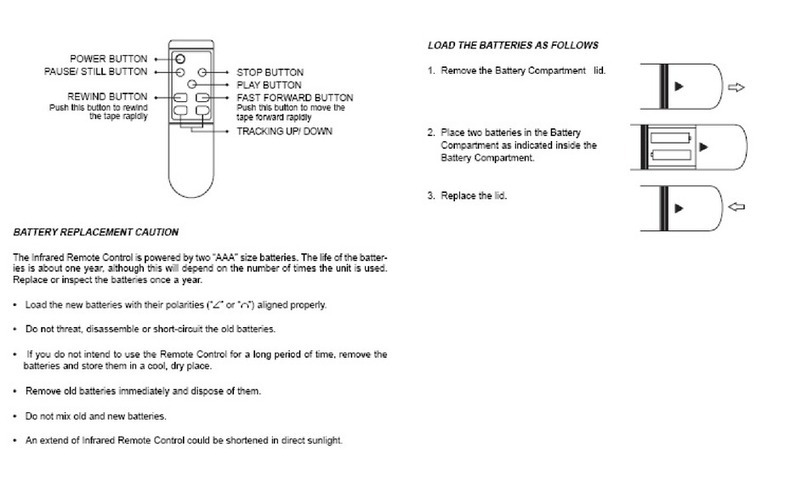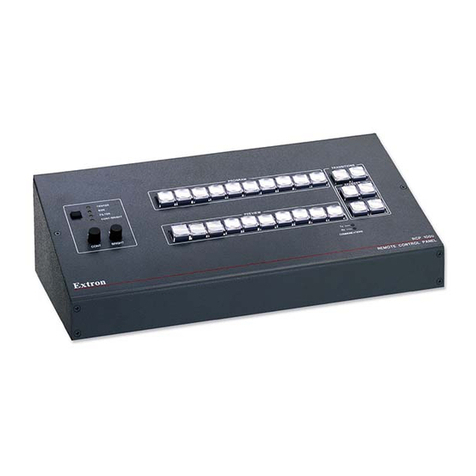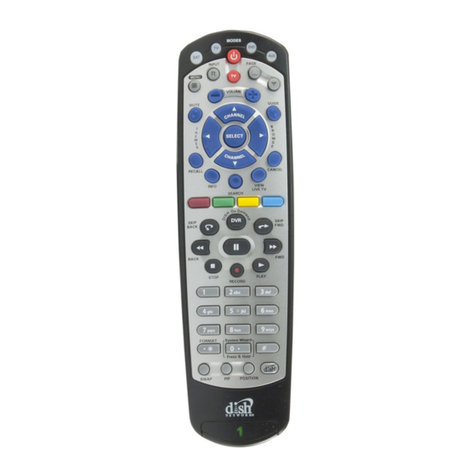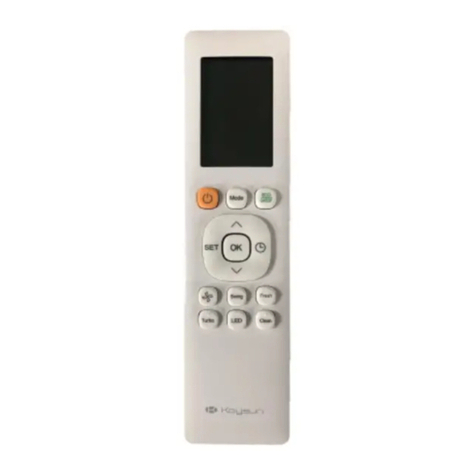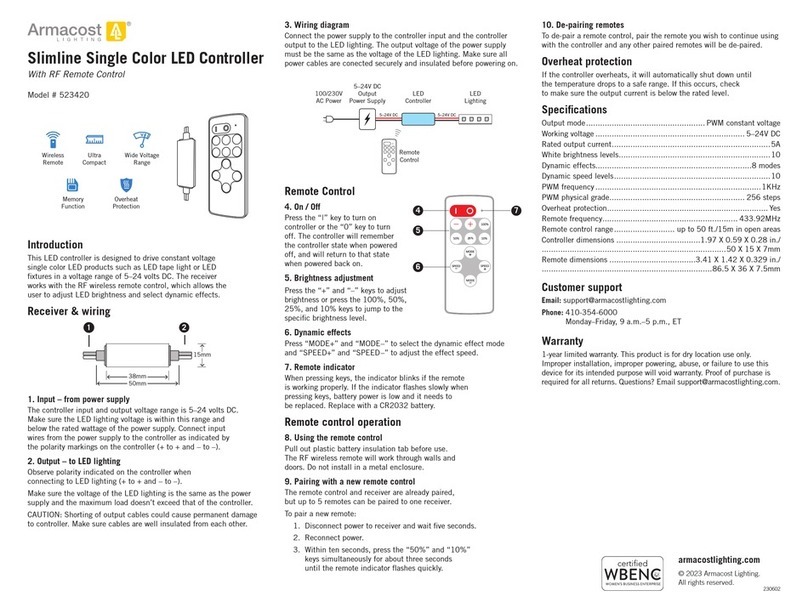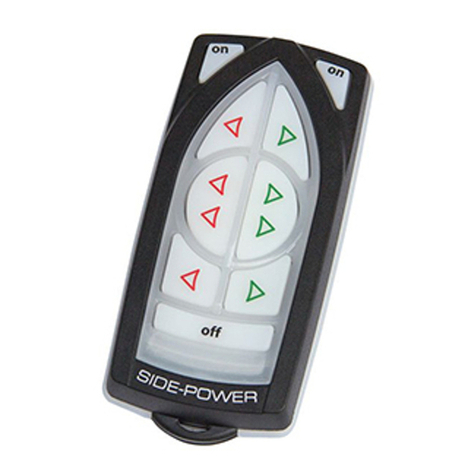Proton 2 Channel FM Radio Control System User manual

HUSKY
FM
FM
2 Channel FM Radio Control System
USER GUIDE
Proton Control Systems, Inc.
yGYUWX
zV~G}GYUW
ཱྀGYWW[GwGjGzGpU

Table of Contents
Page
1. Safety Precautions 4
Transmitter and Receiver 4
Operating R/C 4
Battery 5
Maintenance 5
2. Features
6
3. Preparation & Getting Started
7
- HUSKY 2 Channel FM Transmitter 7
Adaptation for Left-hander 7
Antenna Installation 8
Loading the Batteries 8
Charging 9
Power switch 9
Battery Indicator & Low Battery Alarm 10
USB Connection 10
Direct Servo Control 10
Standing 11
Specification 11
- KEN 2 Channel FM Receiver
12
Installation 12
Frequency Selection 13
Specification 13
4. Data Setting & Programming
14
Name of parts on Control panel 14
Display 14
Programming Map 15
- Direct Accessible Functions
16
Digital Trim 16
Dual Rate 16
Stopwatch / Lap Timer 17
2

page
- System Mode Functions
18
Model Name Entry 18
Frequency & Shift Selection 18
LCD Contrast 19
Trim Rate 19
Data Copy 19
- Pit Mode Functions
20
Model Select 20
Level of Programming 20
Servo Reverse 21
Sub Trim 21
Data Reset 22
- Circuit Mode Functions
23
End Point Adjustment (EPA) 23
Response Sensitivity 24
Dead Band Adjustment (DBA) 24
Start Rate 25
Idle Up 25
Steering & Throttle Speed (Servo Speed) 26
2-Step Steering Speed 27
2-Step Throttle Speed 28
3-Programmed ABS 28
Anti-lock Braking System (ABS) 29
Steering Speed based on Throttle position (SST) 30
5. Approval / Compliance
31
6. Warranty & Service
32
7. Appendix A
33
- Frequency Chart
33
40 MHz, Europe 33
41 MHz, France 35
75 MHz, North America 36
- List of Function & Parameters 37
- Abbreviations
39
Table of Contents (continued)
3

Chapter 1
Thank you for purchasing a Proton Control Systems’ product. Before operating your
Husky transmitter and Ken receiver, please read this manual carefully and retain it for
future reference.
Safety Precaution
Transmitter and Receiver
- Do not operate two or more models on the same frequency at any given time. This
will cause interference and loss of control of models. Although there can be
different methods of modulation (AM, FM(PPM),PCM, etc.) being used, the same
frequency must not be used at the same time, regardless of the signal format.
- Extend the transmitter antenna to its full length. If the transmitter antenna is not
fully extended the operating range of the radio will be reduced.
- Always perform an operating range check prior to use. Do not operate the model if
you notice any abnormality. Problems with the radio control system or improper
installation in a model could cause loss of control.
- Check the transmitter antenna to be sure it is not loose. If the transmitter
antenna works itself loose, or is disconnected while the model is running, signal
transmission will be lost. This will cause you to lose control of your model.
- Be sure to turn on the power switches in the proper sequence. At startup, turn on
transmitter first, and then the receiver. At shutdown, turn off the receiver first,
then the transmitter.
NOTE Before powering on your unit, always make sure the throttle trigger on your
transmitter is at its neutral position. Transmission of the signal can take up to 5 seconds after
the power switch is tuned on. 5 seconds are needed for synthesizing the frequency.
Therefore the power to your receiver should be turned on at least 5 seconds after the
transmitter is powered on so that the receiver can quickly synchronize with the signal from
your transmitter. When turning off the system power switches, always make sure the engine
is not running. If the power switches are turned off while the engine is running or in reverse
order, your model may unexpectedly run out of control.
Operating R/C
- Use this product for surface models only. (Cars, trucks, boats, etc.)
- Do not operate in rain, snow, or if there are puddles of water present. Should any
type of moisture (water or snow) come in contact with any components of the
system, erratic operation and loss of control may occur.
- Operate only when you are fully alert to your surroundings. Do not operate if you
are under the influence of alcohol, drug, or medication. Your impaired judgment
can result in serious injury to yourself as well as others.
- Do not operate in the following places: sites where you may interfere with other
radio control activities, where the general public can be found, on public roads
and near high-tension power lines or communication broadcasting antennas.
- Always perform an operating range check and do not lose sight of you model.
- Do not leave your R/C system or model within the reach of children. A child may
accidentally operate the system and cause injuries to him / himself and others.
Safety Precaution
4

Safety Precaution
Battery
Although the batteries are not included in the product, customers should take
precautionary measures when using and handling batteries.
- Your transmitter has been designed to operate using AA-size batteries. There
include 1.5 volt alkaline and rechargeable 1.2 volt Nickel Cadmium (Ni-Cd)
batteries. Do not attempt to operate the products with incompatible batteries.
- Replace all batteries of a set at the same time. New batteries should not be mixed
with used ones. Do not mix rechargeable and non-rechargeable batteries. Do not
mix alkaline and Ni-Cd types of batteries. Do not mix different grades or brands of
batteries. Failure to observe these precautions may result in some batteries in a
set being driven beyond their normal exhaust point and increase their possibility
of leakage.
- Always check to be sure your batteries have been charged prior to operating the
model. Should the battery go dead while the model is operating loss of control will
occur and create a very dangerous situation.
- Ni-Cd batteries can be very dangerous when mishandled. The acidic fluid from a
Ni-Cd battery, if leaked, can cause serious injuries and chemical damages.
- In the event that battery fluid leaks onto your skin, immediately wash with soap
and plenty of water. Seek medical attention as necessary. In the event that battery
fluid comes in contact with your eyes, do not rub and immediately wash with
plenty of water. Seek medical attention immediately.
- When your R/C system is not being used, always remove or disconnect the
batteries. Should the batteries be left connected, a leakage may result or if
someone accidentally turns on either the receiver or transmitter, a dangerous
situation may be created where models operate without control.
- Always follow your battery manufacturer's directions and guidelines. Do not
attempt to disassemble, short circuit, or subject the batteries to high temperature
or fire.
- When disposing of batteries, follow the manufacturer's instructions and the
guidelines of all federal, state, and local regulations. We recommend customers to
participate in any community battery-recycling programs that may exist in your
area. Contact your local waste remover or recycler for details.
Maintenance
- To keep from damaging your transmitter or receiver, avoid exposing it to moisture,
extreme temperatures, direct sunlight, vibration and dust.
- Clean the outside of the transmitter and receiver by wiping with a clean, dry cloth.
Never use harsh or abrasive cleaners or organic solvents on the transmitter or the
receiver.
- Do not expose plastic parts to fuel, motor spray, waste oil or exhaust. These will
penetrate and damage the plastic.
- Never disassemble or touch the inside of the transmitter or the receiver. This
could result in electrical shock or static and cause damage to the electronic
components inside.
5

Features
Chapter 2
Features
Synthesized PLL Channel Selection - Crystal-Free!
Frequencies of most transmitters and receivers are adjusted by replacing the
crystals. Enthusiasts who want to try on a different frequency channel must also
purchase the corresponding crystal sets. To complicate matters further there are so
many types of crystals based on modulation (FM/AM, PPM/PCM), conversion type
(Single/Dual) and Radio makers. To solve this complicated and costly way of
enjoying R/C, Proton Control Systems implemented the PLL (Phase-Locked Loop)
technology in developing the Husky transmitters and Ken receivers. Your preferred
frequencies is digitally tuned from the menu by simply by pressing buttons. In a
North American model, as an example, all 30 channels in the 75MHz band are
available at your fingertip.
Compatible with all popular FM transmitters & receivers
Your Husky transmitter and Ken receiver are each compatible with all popular FM
transmitters and receivers using the same frequency band. These include Positive
shift (FutabaTM, HitecTM, or KOTM) and Negative shifts (JRTM, SanwaTM or AirtronicsTM).
USB port for PC game control (using optional cable)
Your Husky is more than a transmitter for your R/C models. Use your Husky
transmitter as a joystick (steering and throttle operations only) to control your PC
games.
Interchangeable grip direction for left or right handed drivers
Husky's symmetrical design allows you to change format from right- to left-hand
grip.
Comprehensive programming features
Husky provides 3 modes (System, Pit, and Circuit) of setup fields and 3 levels
(Basic, Intermediate, Advanced ) of programming to make its wide range of features
available for customisation. The programs are simple to set, but offer many
powerful and sophisticated functions.
Other features include :
- LCD menu-driven setup and programming with non-volatile memory saving
- Quick access Digital Trim & Dual Rate buttons with direct display
- 10 model memory with up to 8 characters of model name entry
- Direct Servo Control (using optional cable)
- Servo Reverse, Sub-Trim, Model select, Programming Level & Data Reset [Pit
Mode]
- End Point Adjustment (EPA), Response Sensitivity, Steering Speed, 2-Step
Steering Speed, Throttle Speed, 2-Step Throttle Speed, Start rate, Anti-lock
Braking System (ABS), 3-Programmed ABS (slow, medium, fast), Steering Speed
based on Throttle (SST), Dead Band Adjustments (DBA) and Idle Up features
[Circuit Mode]
- Trim Rate, Frequency & Shift, Contrast and Data copy functions [System Mode]
- Stopwatch with continuous lap timer function
- Audible and visual low battery alarm
- Charging jack receptacle (charger & rechargeable batteries not included)
6

Chapter 3
antenna
function buttons
trim button LCD
time lever
grip
trigger
battery box
steering wheel
control panel
body
Adaptation for Left-hander
Your Husky is factory assembled for right-handers. However the grip direction can
be changed for left-handers by following the directions below.
1. Make sure that the Power switch is set to OFF.
2. Carefully remove the 4 screws from the bottom section of the control panel.
3. Separate the control panel and the body by slowly pulling apart.
4. Rotate the head 180odegrees and carefully reinsert the control panel into the
body. Be carefully not to bend the pin connectors inside.
5. Reinstall the 4 screws. Be careful not to over-tighten the screws.
7
Preparation
Preparation & Getting Started
HUSKY 2 Channel FM TRANSMITTER

Antenna Installation
The antenna included with your Husky is safely stored in a slot underneath the
control panel. To remove the antenna, pull out the plastic retainer cap located at
the front of your Husky transmitter, then slide the antenna out. Insert the base of
the antenna into the antenna receptacle at the top of the control panel. Then screw
the antenna clockwise until it is firmly attached. Be careful not to over tighten the
antenna.
NOTE The antenna should be fully extended while transmitting. Otherwise the operating
range of the system will be reduced, causing a loss of control.
Loading the batteries
Your Husky transmitter requires 8 AA batteries (not included). Alkaline batteries
will provide power for approximately 7 hours of use. The battery compartment is
located at the bottom of the transmitter body.
1. Make sure the Power switch is set to OFF position.
2. Release the hook and the battery cover will pop up.
3. Pull out the battery holder slowly and carefully unplug the connector from the
battery compartment. Install 8 AA batteries into the battery holder.
4. Insert the connector back in and place the battery holder back into the battery
compartment. Press down the battery cover until it locks in place tightly.
8
Preparation

Charging (using optional 9.6V rechargeable Ni-Cd batteries)
In case your prefer to use rechargeable batteries, the charging jack is located on the
back side of control panel where "12V " or "Charge" is marked. Before start
charging, make sure the 9.6V (1.2V X 8) rechargeable NiCd batteries are installed
and the power switch is set to OFF position. It is important that you use only the
DC 9.6V charger that is specifically designed for charging your Ni-Cd batteries. Do
not attempt to charge Ni-Cd batteries with any common voltage adopters. They
typically have incompatible electrical characteristics which can cause harmful
effects on the batteries and on your Husky. Using incompatible charger also poses a
fire hazard. We recommend using a Ni-Cd battery charger which do not exceed the
following specification:
Input voltage : 110V 60 Hz for USA, 230V 50 Hz for Europe
Output voltage : DC 9.6V 150 mAh
Charging jack polarity :
NOTE Never attempt to charge alkaline or non-rechargeable batteries. It can damage the
unit and cause the battery electrolyte to leak and cause additional damages and injuries.
Power Switch (ON, OFF, S/B)
The Power switch is the small toggle switch located back of the Control Panel. It
can be set to On, Off or Standby (S/B) mode. Power On and Off is the same as any
other electronic devices. Standby (S/B) mode allows you to program all functions
without transmitting a radio signal. This is useful for making adjustments while not
affecting others that may be on your frequency. Standby (S/B) mode also uses
about 2/3 less power. If you plan to work in a programming mode for any length of
time or use your Husky as a PC game controller, using Standby will extend your
battery life. " " appears on the LCD display in Standby (S/B) mode.
Preparation
ADV
50 : FM 40.665 MHz 10.3 V
SHIFT : POSITIVE
1 : ALL
STB D/R STA IDL ABS SST
Standby
9
STB

Preparation
10
Voltage Indicator & Low Battery Alarm
Battery Voltage is displayed both numerically and graphically on the LCD display.
The graphical depiction is a horizontal bar on the top right corner of the display.
The length of the power level bar is gradually reduced according to current
consumption. When voltage drops below 8.7 volts, the bar flashes and an alarm will
sound to alert the low voltage condition.
NOTE At low voltage, immediately stop the model and replace the batteries. Otherwise loss
of control of model may result.
ADV
50 : FM 40.665 MHz 10.3 V
SHIFT : POSITIVE
1 : ALL
STB D/R STA IDL ABS SST
Voltage Indicator
USB Connection for PC Game Control (using optional cable)
Your Husky has a USB port located behind the control panel. By connecting a
USB cable between your Husky and a PC, your Husky can function as a PC game
controller or a joystick.
To use as a PC game controller, set the Power Switch to Standby position (S/B),
plug the "B" type end of the USB cable into your Husky and the "A" type end of the
USB cable into the USB port on your PC. The LCD on your Husky will display "USB
Connected". Your PC should recognise the Huksy as a "3 axis 4 button joystick with
hat switch". For the first time use, calibration should be performed by clicking on
the Game Controllers icon in the Control Panel of your Windows PC.
NOTE For a PC Game control, only the Trigger and the Steering Wheel of your Husky are
operational.Trim or Function Buttons are not used and have no effect on a PC game control.
USB cables are available in various lengths at your local computer stores. Look for
a USB printer cable.
Direct Servo Control (using optional cable)
DSC allows you to operate the servos and speed controllers without propagating
the radio frequency (RF). This is ideal for pit checking your radio setup while others
are operating on the same frequency. To operate, plug the radio connector end of
the DSC cable into the DSC jack located behind the control panel of your Husky.
The other male end of the DSC cable is inserted into the battery slot (Slot B) on your
Ken receiver. Set the power switch to ON position.

11
Preparation
Specifications
Number of Channels : 2 (steering & throttle)
Modulation : FM, PPM
Size : 190X185 X118 mm (7.48" X7.28" X4.65")
Weight : 500 g (17.64 oz) w/o batteries
Output power : less than 0.75 W
Current drain : Approx. 250 mA
Power requirements : DC 12V (1.5V X 8, "AA" Size Alkaline batteries),
DC 9.6V (1.2V X 8, "AA" Size NiCd batteries)
Operating temperature : 0oC ~ 40oC
Standing
The large Control Panel at top portion of your Husky makes somewhat top-heavy.
We recommend trying your Husky stands as illustrated below. Depending on your
environment this may allow better stability, better grip approach and ease of pick-
up.

LED
1st digit button /Down
2nd digit button /Up Steering servo slot (Slot 1)
57
Throttle servo slot (Slot 2)
Power slot (Slot B)
KEN 2 Channel FM RECEIVER
Installation
For best performance, your Ken receiver should be firmly affixed and connected to
your surface model according to the procedure below.
1. Locate and decide the mounting position of Ken. Ken and the antenna mast
should be positioned closely to each other, but they should be mounted as far
away as possible from the speed controller, motor, servo, power wires and the
power source in order to minimize the pickup of electrical noise which reduces
the radio range.
2. Clean the surface where Ken is to be mounted.
3. Mount the Ken with double-sided adhesive tape (included). If installed in an
engine powered model, it is recommended that the Ken receiver be mounted with
foam rubber wrapped around to dampen the vibration or shock and to protect
from dirt or oil.
4. Run the antenna wire up through the antenna mast. Do not cut or coil the
excess wire, or radio range will be reduced.
5. For gas powered models, plug the steering servo connector into Slot 1, throttle
servo connector into Slot 2, and power connector into Slot B. For electric powered
models, plug the steering servo connector into Slot 1, speed controller connector
into Slot 2. Be sure the connectors are firmly inserted into the slots to avoid
connections becoming loose due to vibration from the model. Ken receiver
accepts Futaba
TM
, JR
TM
, new KO
TM
and Sanwa
TM
Z connectors.
NOTE Do not cut or coil the excess antenna wire. Cutting, bundling or routing the receiver
antenna wire near any devices that produce noise (RF) will reduce the operating range of the
radio system and result in loss of control. Do not remove the housing case of Ken receiver in
an attempt to reduce weight. This can cause serious damage to the internal circuitry from dirt
or moisture. Removing the case will void Proton Control Systems’ product warranty.
12
Preparation

KEN 2 Channel FM RECEIVER (continued)
Frequency Selection
Ken is a crystal-free receiver. You do not need crystals to change frequencies. In a
North American model, as an example, all 30 channels in the 75MHz band are
available at your fingertip. Each available frequency is assigned with a two-digit
channel number which can be referenced in the [Frequency Chart] located in the
Appendix section of this manual. A two-digit LED display on your Ken shows the
channel number of your chosen frequency. To change the channel number, follow
the steps below:
1. First ensure that your model will not run out of control in any event during the
process of selecting or changing frequencies. For engine powered models, make
sure the engine is not running. For electric powered models, make sure the
wheels are not in contact with the ground or any objects.
2. Make sure your transmitter is powered on with your desired frequency already
set.
3. Switch on the power to the Ken receiver. The current set channel is displayed
on the LED for about 3 seconds.
4. FOR KEN RECEIVERS SOLD IN EUROPE, press left button to change the 1st
digit and the right button to change the 2nd digit of a channel number.
FOR KEN RECEIVERS SOLD IN NORTH AMERICA, press the left button to
decrease or the right button to increase the frequency channel number. Press
either button repeatedly until your desired channel number is reached. Once the
LED display goes off in about 3 seconds, your Ken receiver is turned and ready to
receive signal.
At anytime, by pressing either button momentarily will bring your last set channel
number to the LED display. Subsequent press of either button while the LED is lit
will change the channel number.
Your Ken receiver uses non-volatile memory technology to store its settings. This
means your set channel will not be lost even after the power is disconnected.
NOTE Your Ken receiver’s frequency should always be set to match your transmitter’s
frequency. Otherwise the receiver may receive unwanted signals from other sources, causing
an unexpected accident and damage your model. Make sure to turn the power off when not
in use.
Specification
Number of Channels : 2 (steering & throttle)
Modulation : FM, PPM
Voltage range : 3.5 ~ 10.0 V
Size : 38.1 X 30.5 X 16.5 mm (1.5" X 1.2" X .65")
Weight : 18.70 g (0.66 oz)
Antenna length : 500 mm (19.68")
13
Preparation

Chapter 4
Channel # / Frequency Power level
ADV
50 : FM 40.665 MHz 10.3 V
SHIFT : POSITIVE
1 : ALL
STB D/R STA IDL ABS SST
Dual rate
Start Idle up
Anti-lock braking system
Steering Speed based on Throttle
Standby
Shift
Level
Model # & Name / Stopwatch
LCD
Trim button
mode button
enter/stopwatch button
down / idle up button
up / start button
+,- / dual rate button
antenna receptacle
steering wheel
14
Data Setting & Programming
LCD Display
When the power switch is set to ON or Standby (S/B) the normal LCD display shows
as illustrated below. The STB, D/R, STA, IDL, ABS and / or SST are displayed only
when such functions are programmed or activated.
Data Setting & Programming - Husky Transmitter
There are 3 modes (System, Pit, and Circuit) of setup fields and 3 levels (Basic,
Intermediate, Advanced ) of programming under the Circuit Mode. This chapter explains
how individual parameter can be adjusted.
Names of Parts on Control Panel
NOTE Actual display on your Husky may appear slightly different than above,
depending on the product's region, frequency band or the software version installed.

15
Data Setting & Programming
Programming Map
The following map shows how the programming menu is laid out. Each function is
explained in detail on pages 18 through 30. Detailed list of individual parameters
with the factory default values can be found in the appendix [List of Functions &
Parameters].
Mode Function
SYSTEM Model name (entry) Country*
Frequency Shift
Contrast (LCD) Frequency
Trim rate
Data copy (of models)
PIT Model (select)
Level (of programming) Reverse
Servo
Reset (data) Sub trim
CIRCUIT Basic Intermediate Advanced
EPA EPA EPA
Response Response Response
DBA Start / Idle up Start / Idle up
DBA DBA
Servo speed Servo speed (2 step)
ABS (programmed) ABS (detailed)
SST
* Country selection available on 40MHz models only. 75MHz models are fixed with Country
USA

Steering R00
Throttle F00
[ Trim ]
Directly Accessible Functions
Using the buttons on the control panel, the Digital Trim and the Dual Rate
functions can be adjusted quickly and easily. Make instant fine adjustments
without having to move around the LCD menu. The Stopwatch function is also
accessed directly. Activation buttons for the Start Rate and the Idle Up
functions are also available on the control panel.
Digital Trim
The digital trim button is located on the left side of the control panel. Steering and
Throttle trim adjustments can be made by pressing the trim button in one of the 4
available directions. Up and down are for Throttle trim and right and left are for
Steering trim. You will hear a beep with each increment of trim adjustment. The
amount of each increment is based on the Trim rate which is programmable in the
System mode. The trim positions are displayed both numerically and graphically on
the LCD.
NOTE Throttle trim changes only the center (neutral) point and not the end points. This is
done to maintain your maximum speed and braking points.
Dual Rate
Dual rate adjusts the total steering servo throw simultaneously to the left and to
the right end points. Reducing the dual rate value makes the steering less
sensitive as the maximum amount of steering available is reduced. By pressing
the the or buttons on the control panel. dual rate values are quickly adjusted
with the result displayed on the LCD simultaneously. Note that the dual rate
works in conjuction with the EPA settings in Circuit Mode. Nay charges you make
to EPA settings will have an effect on dual rate values.
16
Data Setting & Programming
Throttle trim
Steering trim
Steering trim
Throttle trim
Rate
right turn 100%
left turn 100%
[ Dual rate ]
Dual Rate

Stopwatch / Lap Timer
Pressing the " " button on the control panel will activate the stopwatch function
and display the timer on the LCD. The timer is started when the throttle is triggered
and the lap stop is displayed when the blue lap time lever behind the steering wheel
is pressed. To reset, press the " " button, or to resume, press the blue lap time
lever again.
17
Data Setting & Programming
Start trigger
Lap time
(blue lever)
ADV
50 : FM 40.665 MHz 10.3 V
SHIFT : POSITIVE
00 : 00 : 00
STB D/R STA IDL ABS SST
Timmer
activate
& reset

Model name 1 : MODEL1
Frequency
Contrast
Trim rate
Data copy
System mode
1 to 2
12
10
Data Setting & Programming
Country : Germany
Shift : Positive
Frequency : 50 : 40.665 MHz
[ Frequency ]
Model name 1 : MODEL1
Frequency
Contrast
Trim rate
Data copy
System mode
1 to 2
12
10
Frequency & Shift Selection
The frequency feature allows selecting Countries, frequencies and shift types. There
are 2 kinds of shifts: Positive shift for FutabaTM, KOTM, HitecTM type of receivers and
negative shift for JRTM,SanwaTM, AirtronicsTM type of receivers. By selecting frequencies
and shifts accordingly, Husky can work with all popular FM receivers of others.
Note Band change is not possible in a given unit (for example: 27MHz to 75Mhz or 75MHz to
27MHz). To control a 27MHz FM receiver, you must purchase a 27MHz transmitter.
Frequencies can be changed, but only within a specific band.
1. Press button until the cursor is at Frequency.
2. Press button to display Frequency screen.
3. Press / button and or button to select the country. (For Euro model
only)
4. Press button until the cursor is at Shift.
5. Press button for "positive" and press button for "Negative"
(Press to confirm the new Shift or button to retain the previous Shift.)
6. Press button until the cursor is at Frequency.
7. Press or button until your desired frequency is displayed.
(Press button to confirm the new Frequency or button to retain previous
Frequency)
8. Press button returns to the System Mode menu.
System Mode Functions
As shown in the Programming Map on page 15, System mode provides the
programming for Model name entry, Frequency selection, LCD Contrast, Trim Rate,
and Data Copy. These basic settings apply to the transmitter system regardless of
the pit and circuit mode settings. The System Mode menu is accessible as follows:
1. Press button at normal display.
2. Press button twice until the cursor is at System Mode.
3. Press button to display the functions available under the System Mode.
Model Name Entry
For ease of identification, the model name function allows you to assign names up
to 8 characters in length for each of your models up to 10 models. Following the
memory location numbers, your model can also be identified by a number (0~9),
which is always displayed before the model name. To begin model name entry;
1. Press or button until desired letter appears. (A~Z, a~z, 1~0, space)
2. Press once to confirm the letter, and press or to select the next letter.
3. Press button once again to save the model name.
18

Model name 1 : MODEL1
Frequency
Contrast
Trim rate
Data copy
System mode
1 to 2
12
10
Model name 1 : MODEL1
Frequency
Contrast
Trim rate
Data copy
System mode
1 to 2
12
10
Data Copy (Model Copy)
This function copies the entire contents of the currently stored model memory to
another model memory. The model name which may already exist at the target
memory location is not replaced by this operation.
1. Press button until the cursor is at Data Copy.
2. Press / until the desired target model number appears.
3. Press button to copy. When the copy is completed, "C" is displayed briefly.
4. Pressing button returns to the Mode menu.
Model name 1 : MODEL1
Frequency
Contrast
Trim rate
Data copy
System mode
1 to 2
12
10
Trim Rate
The trim rate function allows the trim authority (the amount of increment or
decrement of trim adjusted for each press of Digital trim button) to be adjusted. It
allows trim control with fine or rough adjustment.
1. Press button until the cursor is at Trim Rate.
2. Press or button to adjust trim rate.
(Press button to complete setting or pressing button to return to previous
setting)
3. Pressing button returns to the Mode menu.
LCD Contrast
This function allows a twenty-level contrast adjustment of the LCD screen.
1. Press button until the cursor is at LCD contrast.
2. Press or button until the desired contrast is achieved.
(Press button to complete setting or pressing button to return to previous
setting.)
3. Pressing button returns to the Mode menu.
Data Setting & Programming
19

PIT Mode Functions
This mode contains programming for setup during model building, electronics
installation and maintenance. Pit Mode features model selection, programming level,
servo direction and sub trim. The Pit Mode menu is accessible as follows.
1. Press button at normal display.
2. Press button until the cursor is at Pit Mode.
3. Press button to display Pit Mode menu.
Programming Level
Your choice of programming level affects which of the Husky's functions will be
available for customization in the Circuit Mode programming. For example, the Basic
level allows you to make adjustments on EPA, Response and DBA in the Circuit
Mode. Other sophisticated functions such as ABS or SST are available in the
Intermediate or Advanced Level operations. Basic level works well for those who want
to quickly set-up with some basic functions and go right to the race, The Intermediate
and the Advanced levels offer more detailed programming capabilities to meet the
needs of more serious racers. Please refer to the programming map for the list of
functions available under each programming level.
1. Press button until the cursor is at the Setting Level.
2. Press or button until your desired level is displayed.
3. P
ress button to complete setting or button to return to previous setting.)
3. Pressing button returns to the Mode menu.
Model Select
Your Husky can keep and handle the data for 10 individual models. Whenever you
make any changes to the functional parameters, including the Digital trim and the
Dual Rate settings, the data is automatically saved into the memory. The saved data
is uploaded by using the Model Select. This function is not only useful for someone
who has many cars, but great for quick setting changes by bringing up the model
with all the data already programmed in previously. To have a Model Select;
1. Press or button until the desired model number appears.
2.
Press button to confirm or button to cancel.
2. Pressing button returns to the Mode menu.
Model 1: SPEED
Level Basic
Servo
Reset NO
Pit mode
Model 1: SPEED
Level Basic
Servo
Reset NO
Pit mode
20
Data Setting & Programming
This manual suits for next models
1
Table of contents
Popular Remote Control manuals by other brands

Alpine
Alpine RUE-4191 owner's manual
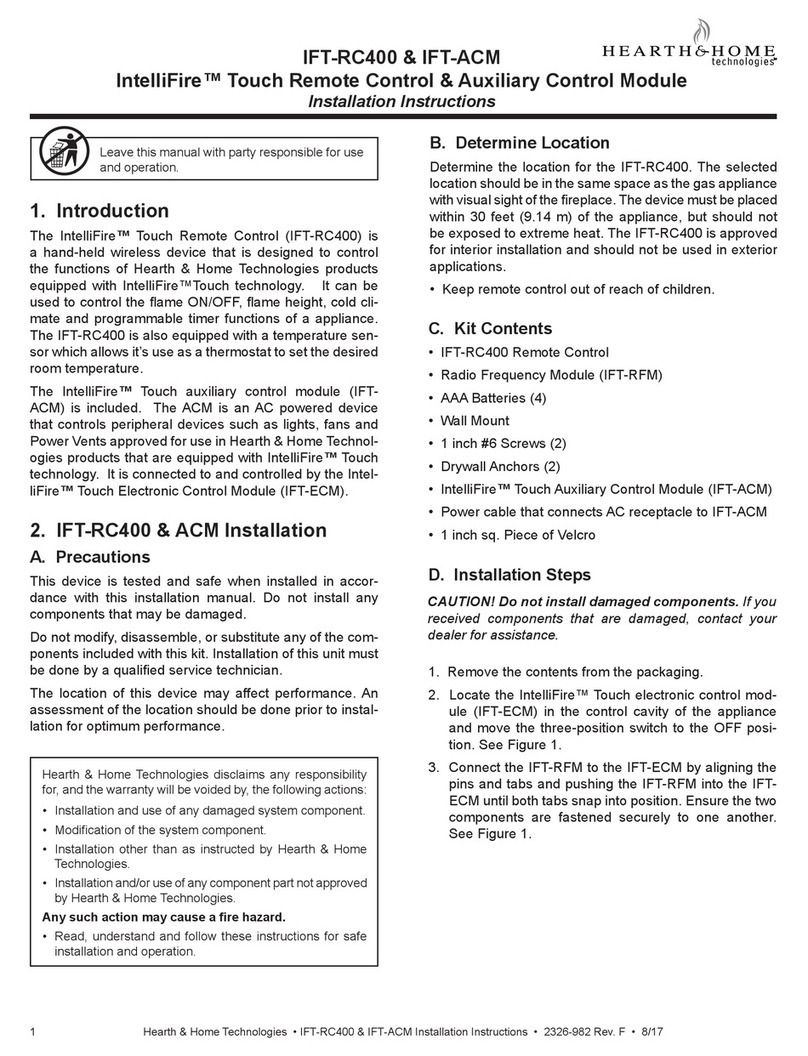
Hearth & Home
Hearth & Home IntelliFire IFT-ACM installation instructions
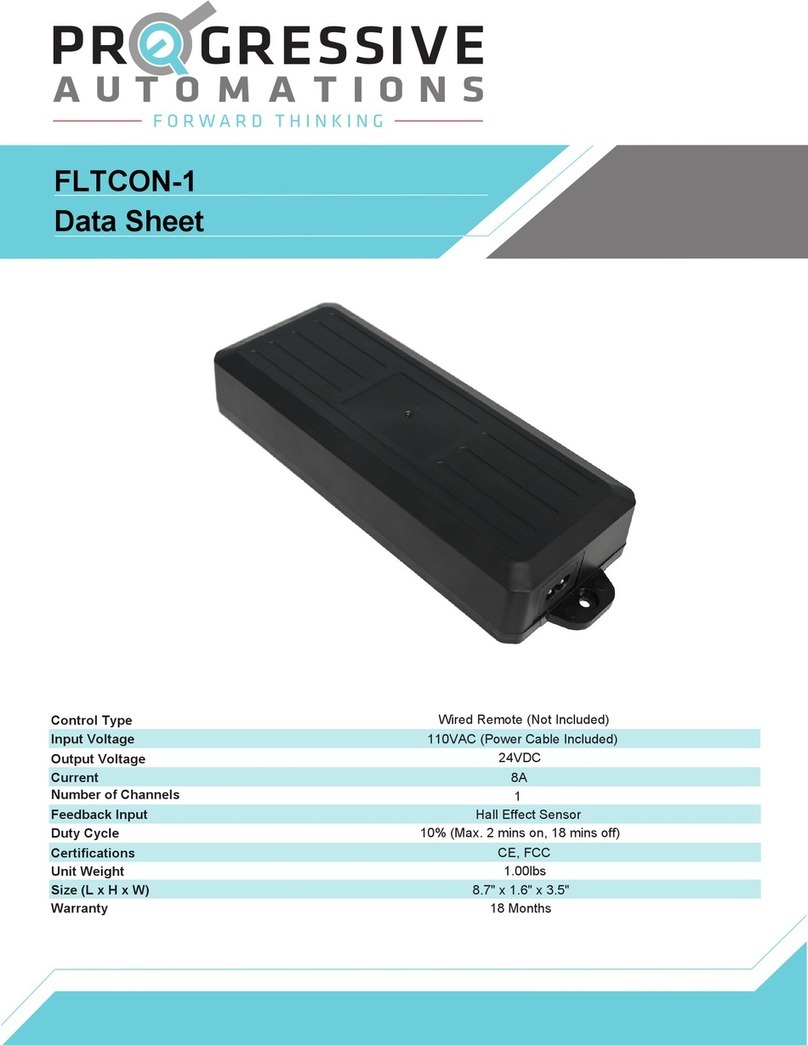
progressive automations
progressive automations FLTCON-1 datasheet
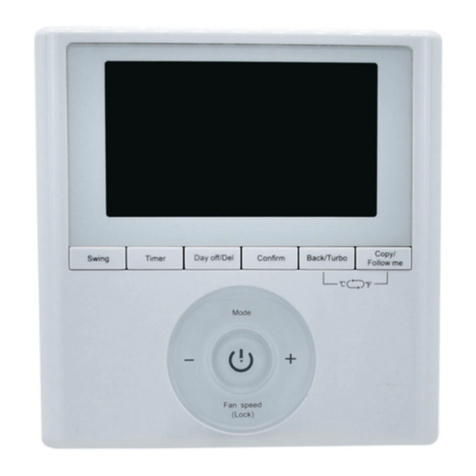
Lennox
Lennox KJR-120G1/TFBG-E Installation and owner's manual

Positive posture
Positive posture CAFE operating instructions
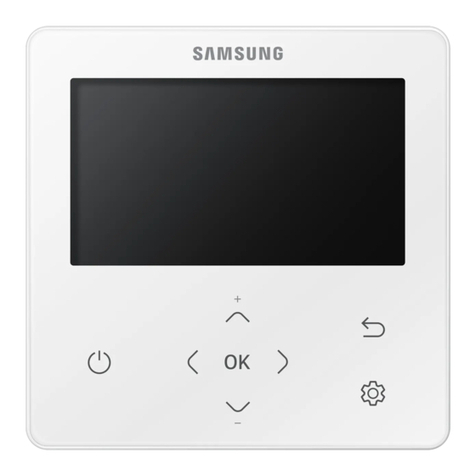
Samsung
Samsung MWR-WW10JN user manual
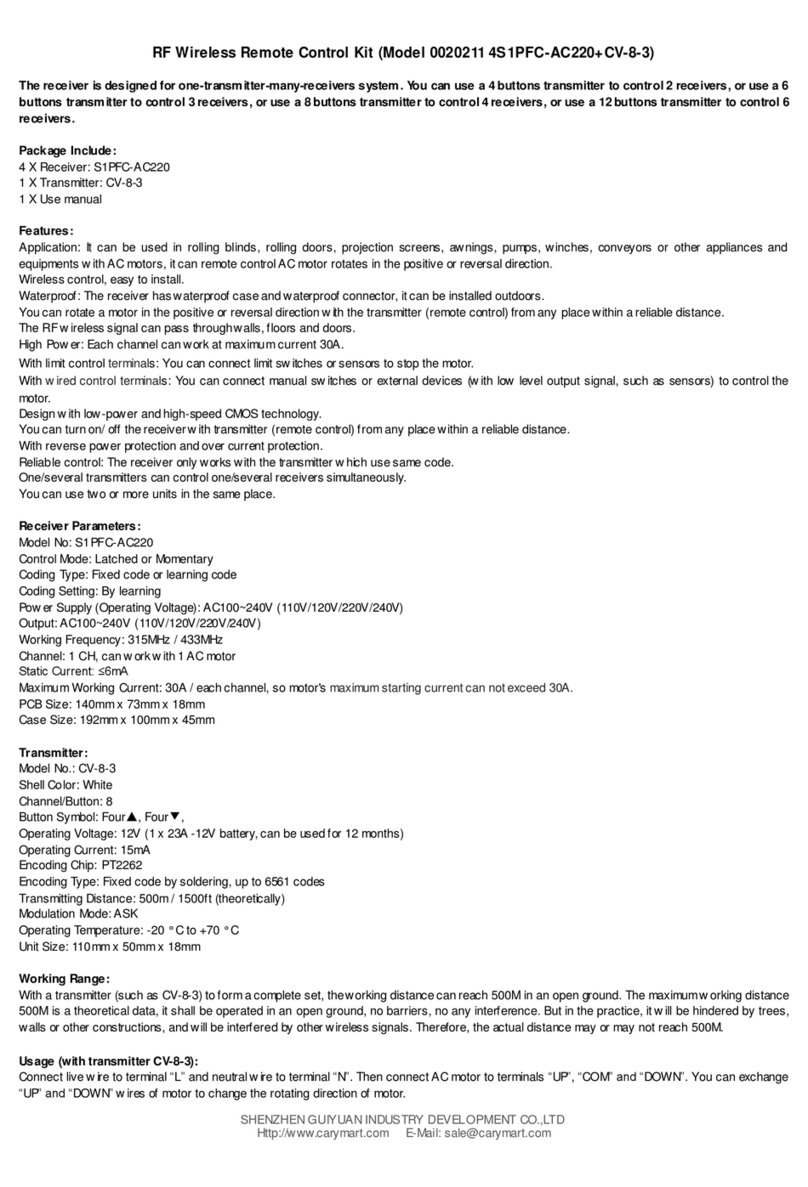
Flying Industry Development
Flying Industry Development 4S1PFC-AC220+CV-8-3 quick guide
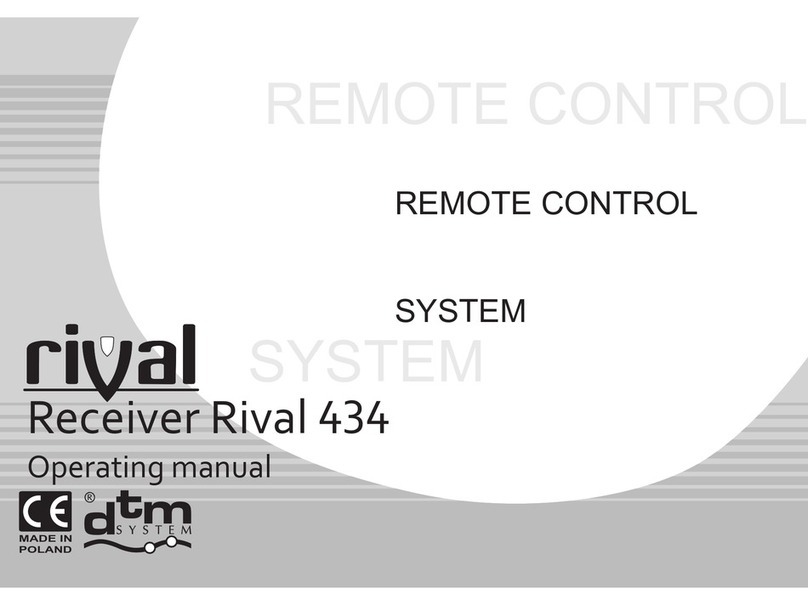
DTM System
DTM System RIVAL 434 operating manual

Goodmans
Goodmans 336NS manual
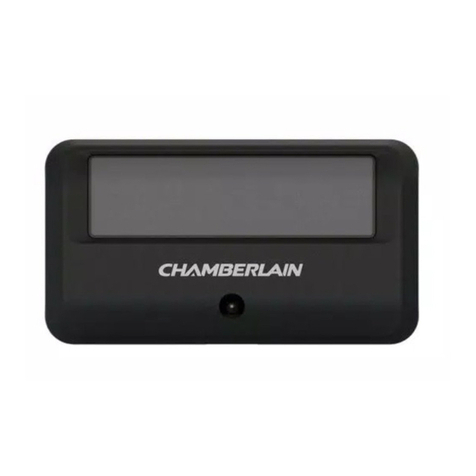
Chamberlain
Chamberlain 950ESTD quick start guide
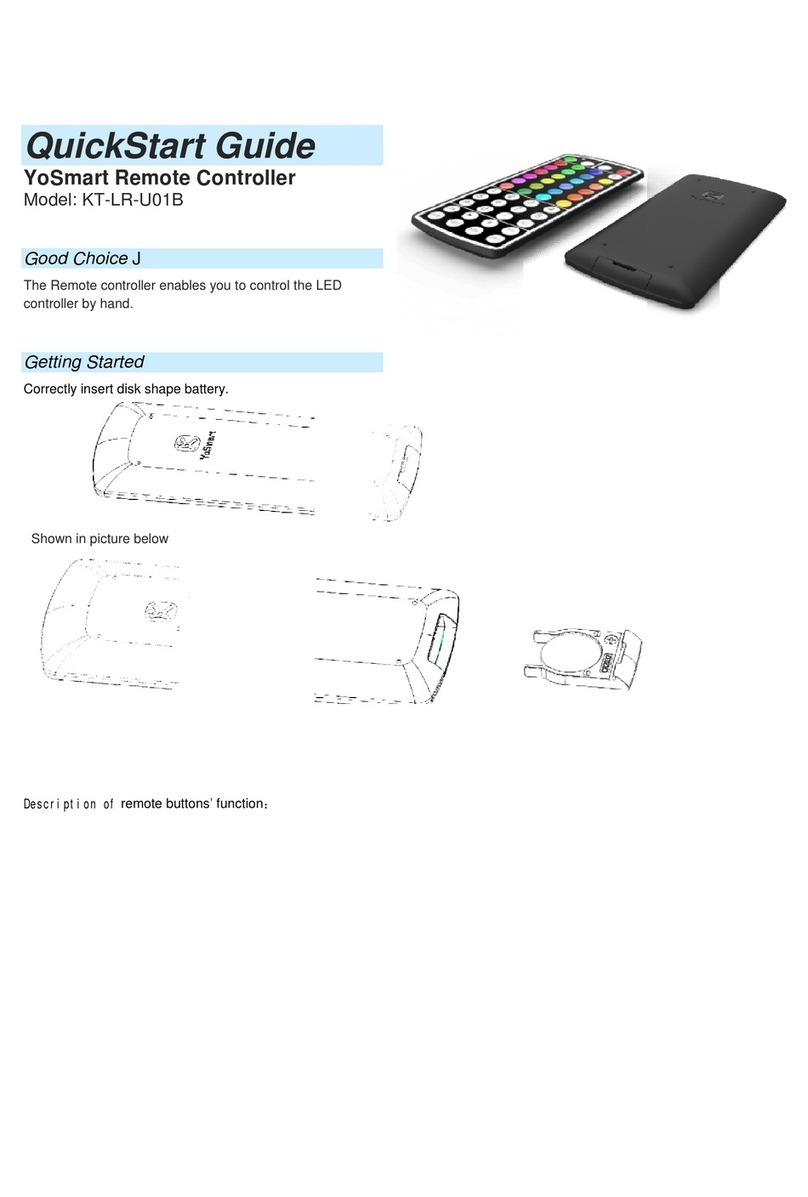
YoSmart
YoSmart KT-LR-U01B quick start guide
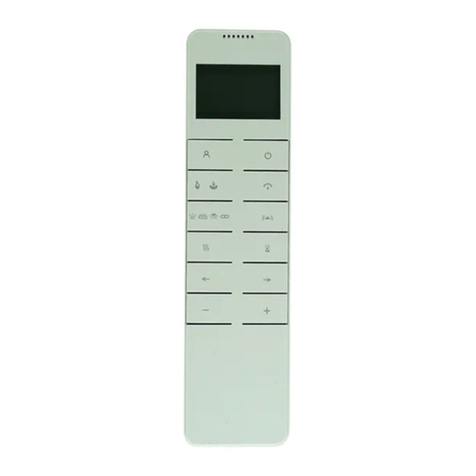
Regency Fireplace Products
Regency Fireplace Products Onyx Remote Control manual
